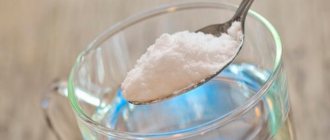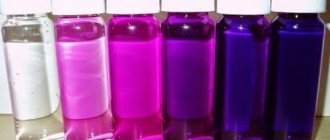Sodium fluoride, which is included in toothpaste ingredients, is common. Previously, this component was not so common, but now when choosing a suitable toothpaste, you should carefully study the ingredients. Each composition fits a specific diagnosis, and in some situations the presence of fluoride will be beneficial or harmful. You need to figure out what positive and negative properties this substance has.
Why do teeth need fluoride and is it needed in toothpaste?
Research on the effect of fluoride on the condition of teeth and the entire body is constantly being conducted. Fluoride-containing compounds are found not only in toothpastes, but also in various foods, in medicinal mineral waters, and they are added to vitamin complexes. The main thing is that their content does not exceed acceptable standards, within which there is no negative impact on humans.
The effect of fluoride on tooth enamel is caused by several mechanisms:
- already during the formation of baby teeth at an early age, fluoride accumulates in tooth enamel, ensuring its strength;
- in adults, ions of this mineral are also constantly concentrated in the teeth, providing them with a strong enamel layer;
- fluoride prevents demineralization of tooth areas and has a bactericidal effect.
The development of caries and its further complications largely depends on the demineralization of individual areas of the tooth. Human saliva contains a sufficient number of bacteria that affect its increased acidity, resulting in an aggressive effect on the enamel surface. As a result, it lacks such important microelements as phosphorus and calcium.
Fluorides prevent mineral loss and fight microorganisms in saliva. At the same time, having a toxic effect on bacteria, they also have an adverse effect on human cellular structures.
How to strengthen teeth effectively and without harm to health?
In the prevention of tooth decay and gum disease, hygiene is of paramount importance. At the same time, it is not only toothpastes that protect against pathogenic bacteria. The main thing to remember is that microbes multiply when the acid-base balance is disturbed. And you can restore this balance if you simply rinse your mouth thoroughly after eating.
Diet is also very important. Don't forget to eat solid plant foods: carrots, apples, cabbage . This will strengthen your teeth and gums and help cleanse your mouth naturally.
To prevent periodontitis, it is recommended to take a supplement such as Osteomed . It contains calcium citrate, which is perfectly absorbed, and another component of the drug is drone homogenate . It is the source of all the amino acids, vitamins and minerals needed for our health. Calcium citrate supplies the mineral to teeth and bone tissue, and drone homogenate normalizes hormonal levels and improves metabolic processes. The action of these two components gives a synergistic effect, which perfectly protects teeth and gums from diseases.
How to avoid joint pain?
No one thinks about how to avoid pain in the joints - the thunder hasn’t struck, why install a lightning rod.
Meanwhile, arthralgia - the name of this type of pain - affects half of people over forty and 90% of those over seventy. So preventing joint pain is something worth thinking about, even if you... Read more
The power of hormones. What active substances regulate cartilage restoration?
The state of a person and the coherence of the organs of his body are largely determined by hormonal balance.
Cartilage restoration is also subject to the influence of ubiquitous life regulators. Without normalizing hormonal levels, complete regeneration of the joint is impossible. What strings does the invisible puppeteer, the endocrine system, pull, influencing cartilage tissue? Testosterone This hormone is produced by the gonads and adrenal cortex, as in... Read more
Lecture by Dmitry Elistratov, General Director of Parapharm, about the discovery of Professor Strukov and the osteoprotectors he developed
My goal is to tell you about an amazing discovery made by a Penza doctor, Professor Villoriy Ivanovich Strukov.
He has been researching bone tissue for more than 60 years, and more than 10 thousand patients have received his help. This doctor is also famous for having trained many specialists in the treatment of osteoporosis and written several monographs. He owns more than 300 patents for inventions around the world.… Read more
What harm does excess fluoride cause to teeth?
In acceptable quantities, fluorides have a positive effect not only on tooth enamel, but also on the condition of the body as a whole. They affect the human skeleton, ensuring its strength and elasticity, and the condition of nails and hair. Their deficiency can disrupt the balance of the internal environment of the body and teeth in particular. In this case, excess can have more serious consequences and cause the formation of defects: characteristic spotting on the surface of the teeth, crumbling of the enamel.
In dentistry, this disease is called fluorosis - it is a common pathology associated with damage to the enamel due to prolonged excessive accumulation of fluoride compounds in it.
Children are more susceptible to this disease. Their daily need for this mineral ranges from 2-3 mg and is fully satisfied with water and food. When using fluoride-containing pastes, an overdose can easily develop. That is why dentists agree that children can use such pastes only with a special prescription from a doctor. Brushing your teeth should be done under adult supervision.
In an adult, the daily need for fluoride is higher – 4-6 mg. Acute overdose is rare; long-term chronic poisoning with fluorine-containing compounds occurs more often.
Importance of fluoride for the body
Of course, fluorine plays a big role for every organism. It is thanks to it that it is possible to maintain the strength of bone tissue; the growth and condition of teeth, hair and nails depend on it. Fluoride is especially important during a person’s growing up period: without it, the child’s skeleton will not be able to develop normally.
Fluorine affects the metabolic process, and with its help, dangerous and heavy metals are better removed from the body. Without it, it is impossible to maintain immunity, and iron is absorbed much worse.
With a lack of fluoride in the body, bones become curved, become fragile and brittle, and heal less well in the event of a fracture. Teeth also depend on it: enamel, suffering from a lack of this substance, gradually becomes thinner. Bacteria from soft plaque have a stronger effect on it, resulting in rapid development of caries. That is why toothpaste containing fluoride is the choice of many people who have dental problems.
Symptoms of fluoride poisoning and its consequences
Chronic fluoride poisoning can manifest itself not only in changes in tooth enamel, but also in the appearance of other symptoms. These include:
- causeless weight loss;
- anemia;
- the appearance of general weakness and dizziness;
- impaired mobility in joints;
- the appearance of endocrine diseases, in particular dysfunction of the thyroid gland;
- increased bone fragility.
These signs can also appear in other diseases. It is important to draw the doctor’s attention to the fact of using toothpaste.
If these symptoms appear, you must:
- Completely eliminate further entry of fluoride-containing substances into the body.
- Seek specialized help from a doctor for additional examinations and symptomatic treatment.
- Take measures to remove the mineral from the body as quickly as possible.
Cases of acute poisoning at home are more common when children swallow large amounts of fluoride toothpastes. The main symptoms are abdominal pain, nausea, and vomiting. In case of severe intoxication, severe headaches and seizures may occur.
In case of acute fluoride poisoning, it is necessary to urgently call an ambulance. Until this time, rinse your stomach by drinking as much clean water as possible.
Colgate "Maximum Cavity Protection"
The list of popular remedies includes Colgate. Toothpaste against caries contains fluoride and liquid calcium, thanks to which it strengthens and protects the enamel. There is an additional pleasant effect: the paste destroys colored plaque, and with prolonged use, teeth become noticeably whiter.
The product has a pleasant minty flavor and helps freshen breath for a long time. Despite the popularity of the Colgate brand, this toothpaste is not suitable for children, but it is quite suitable for adults and teenagers.
How to remove a mineral from the body?
The substance is independently eliminated from the body over a certain period of time. However, there are several techniques to help speed up its elimination:
- Special therapeutic diet. Avoid frequent consumption of tea, pay attention to natural products without industrial processing. Some sources recommend eating plenty of fresh watermelon.
- Water quality. Tap water is often fluoridated to disinfect it. In this case, it is recommended to use special carbon filters. You can also buy special purified water for drinking and cooking.
- Consume sufficient amounts of iodine and bromine. These elements help remove fluoride from the body. It is important to avoid their overdose.
- Dry saunas. They provide increased sweating, due to which there is increased excretion of the substance through sweat. A prerequisite for these procedures is adequate maintenance of water balance. It is important to avoid dehydration.
Splat
The Splat line includes several toothpastes without fluoride. “Biocalcium” perfectly restores and polishes enamel, heals small wounds on the oral mucosa. The paste tastes sweetish, with a slight mint flavor.
“Splat Maximum” reanimates damaged areas of the tooth surface, quickly and carefully eliminates dangerous soft plaque, blocks the proliferation and spread of microbes and soothes inflamed gums. In addition, stains from cigarettes or strong colored drinks are easily removed from the enamel.
Dangerous fluorine-containing compounds for humans in toothpaste
In toothpastes, fluoride is bound and is an inactive form. Only when entering the body, under conditions of body temperature and interaction with saliva, its active ions are released from fluorine-containing compounds. The main such connections are:
- Sodium monofluorophosphate. It is characterized by slow decomposition into ions, due to which it is considered ineffective in dental practice. During brushing your teeth (1-3 minutes), the required amount of fluoride is not released.
- Sodium fluoride. Most often used in toothpastes. A compound that actively dissociates into ions. It has good properties for restoring the mineralization of teeth. Can be used by children.
- Aminofluoride (ophthalur). Has high remineralizing ability. Additionally, it creates a thin film on the enamel, from which fluoride penetrates into the tooth enamel for a long time after brushing. It is the most active component of toothpastes.
- Tin fluoride. Currently, it is rarely used in dentistry, since it has a number of side effects: possible staining of tooth areas in a dark color, change in the color of the filling, increased inflammation during periodontitis.
Paradontax with fluoride
Toothpaste against caries "Paradontax with fluoride" was created specifically to combat this disease. It contains added sodium fluoride, which helps start the process of enamel remineralization. In addition, this remedy perfectly relieves bleeding gums.
It can be used by adults and children over fourteen years of age. “Paradontax with fluoride” differs from the usual line by its specific salty taste. The paste is suitable for long-term use, but the condition of the teeth must be monitored. If light spots appear, indicating an excess of fluoride, it is better to choose another product.
Amount of fluoride in products from various manufacturers
Popular fluoride-containing pastes are discussed below depending on the amount of this mineral in them:
- PRESIDENT Classic. The active ingredient is sodium fluoride, the total fluoride content is 1450 ppm. An additional active substance in the composition is xylitol, which also has a strong cariesstatic effect.
- Colgate Maximum protection against caries. The active substance is sodium monofluorophosphate, additionally contains a substance to protect the enamel - liquid calcium, fluoride content - 1450 ppm. Approved for use by children over 6 years of age under adult supervision.
- Blend-a-Med with active fluoride. Contains sodium fluoride in an amount of 1450 ppm. Constant use is not recommended; it must be alternated with other toothpastes that do not contain fluoride.
- Paradontax with fluoride. Active ingredient: sodium fluoride, 1400 ppm. The manufacturer indicates that the product is suitable for daily use by adults. It is not recommended for children under 12 years of age, since the maximum allowable amount of the mineral for them is significantly exceeded (200–500 ppm).
- SPLAT "Arktikum" - contains sodium fluoride and amino fluoride. Their total content is low - 1000 ppm, due to which the paste can be recommended for regular use
Sherbet™ Neutral 2% Sodium Fluoride Mouth Rinse Solution
"Fundamentals of exogenous dental
prevention and topical anesthesia
using the example of SherbetTM products"
Authors: Borisov N.A.
Borisova A.N.
Fluoride solutions for prophylaxis are used both for applications and for rinsing. For rinsing, neutral or acidified aqueous solutions of sodium fluoride are used. Few companies make ready-to-use rinses for children and adults, and the effects of fluoride on teeth and plaque provide significant preventive benefits, provide therapeutic benefits for periodontal infections, and help maintain a healthy mouth. Therefore, the appearance of a drug registered for use on the territory of our state can significantly contribute to the improvement of childhood prevention carried out in an organized way in school institutions of the country.
Indications for choosing a rinse for the patient:
1. Medium and high risk of developing dental caries, especially in the pre- and pubertal periods, sub- and decompensated forms of caries, 2. Focal demineralization of hard dental tissues, 3. Dental hyperesthesia, 4. Wearing orthodontic and orthopedic devices, 5. The presence of braces in the patient, 6. Metal-ceramic structures in the oral cavity or restorations of the frontal group of teeth (due to the fact that acidified compounds can cause corrosion of the metal and remove the natural shine from the restorations). 7. Gum recession. 8. Carrying out periodontal therapy. 9. Xerostomia, including conditions after radiation and/or drug therapy with drugs that inhibit the function of the salivary glands. Fluoride solutions are traditionally used as rinses in school prevention programs throughout the world. Such rinse programs are especially recommended in regions where water is not fluoridated and there is a medium or high rate of caries in the population.
Contraindications:
Age under 6 years, inability to rinse mouth.
Advantages:
Mouth rinses with fluoride provide an additional preventive effect in children with low rates of dental caries, even in regions with optimal concentrations of fluoride in drinking water. The maximum preventive effect is observed in children with high intensity of dental caries. After the cessation of such programs, the caries preventive effect persists for several years. Fluoride rinses in schools require little time (about 2 minutes every three months); school-age children easily learn the technique of the procedure. The program is inexpensive and highly cost-effective. Non-dental staff with minimal training are able to organize and supervise these procedures (they may be assisted by older children and parents).
Flaws:
1. Danger of poisoning if fluoride solution is swallowed. 2. Impossibility of use in young children. 3. Insufficient effect in the area of fissures and pits of teeth.
The combination of mouth rinses with fluoride solutions with other local methods of preventing dental caries gives the greatest effect. For example, the simultaneous use of fluoride toothpastes and fluoride mouth rinses gives a greater total effect than either of them alone. The combination of regular rinsing with fluoride solutions and brushing teeth with fluoride toothpastes can reduce dental caries by up to 90%, especially on proximal surfaces.
Neutral solution (Ph = 7) Sherbet™, containing 2% sodium fluoride, has a pleasant menthol or fruit punch taste, to choose from.
The correct choice by the physician of acidified phosphate fluoride (APF) or neutral sodium fluoride (NaF) holds the key to the treatment of specific clinical cases and contributes to positive patient responses to procedures performed in the physician's office. This greatly helps in the argument and creates a positive background for the patient's reaction to fluoride prescribed by a doctor for additional use at home.
Neutral sodium fluoride (NaF) first appeared in the early 1940s as a 0.1% aqueous rinse recommended for use at four-month intervals for two years. NaF is now used in the form of a 2% gel and is recommended for patients with root caries, xerostomia, for use by orthodontic patients and in the presence of cosmetically restored teeth in the oral cavity (combined crowns, porcelain or composite restorations). Although NaF is extremely effective, it is recommended to apply it within four minutes due to its neutral PH. Recently, it has been found in clinical settings to reduce tooth decay and have the best effect on patients when used at three-month intervals, accompanied by doctor-prescribed fluoride for home use.
In the next section, we would like to tell you about clinical studies that show the methods and effectiveness of using rinsing solutions: Most often, rinsing is used as the main method of prevention, starting from the age of 6. Typically, this procedure is carried out in classrooms by teachers, nurse hygienists or volunteer assistants after some instruction. As a rule, the rinsing procedure lasts no more than 2 minutes using 5-7 ml of solution. Small children use 5 ml. Mouth rinsing is contraindicated in children under 6 years of age, as they may accidentally swallow the solution and often do not know how to rinse their mouth. Bibby BG (1946) was the first to use fluoride solutions in the clinic for the prevention of dental caries. Fluoride mouth rinses gave good results both in children living in areas with suboptimal fluoride levels in drinking water, and in children receiving inadequate fluoride therapy (Weiz WS, 1960; Torel P., Ericsson Y., 1974). McDonald RE, Avery D. (1989) recommend additional rinsing of the mouth with chlorhexidine solutions. Radike A. et al. (1973) reported that a significant effect was obtained in schoolchildren who rinsed their mouths daily with a 0.1% SnF2 solution. Over the course of 2 years, there was a reduction in caries according to the KPUz index by 33% and KPUpov. – by 43%. Aminofluorophosphate (APF) rinse solutions containing 100 or 200 ppm fluoride were also effective when administered to school children for 26 months (Finn et al., 1975). The national program for the prevention of caries using mouth rinses, conducted among 85 thousand American schoolchildren, confirmed theoretical studies (Muller B., 1977). In kindergartens, among 4,500 6-year-old children, a caries prevention program, including weekly mouth rinsing with a 0.2% neutral sodium fluoride solution under the supervision of a teacher, resulted in a reduction in dental caries of 20.4%, and of surface caries by 24.4%. The greatest reduction of caries was observed on the approximal surfaces (49.6%), less - on the occlusal (21%) and buccolingual (18.8%) (Lemke SV, 1981). Fluoride mouth rinses provide an additional preventive effect in regions with optimal concentrations of fluoride in drinking water (Ruiken HM et al., 1987) and in children with low rates of dental caries (Scheets JP et al., 1984). The effectiveness of daily procedures and mouth rinses once every 2 weeks is almost the same, but the daily method requires more time from participants and supervised personnel, and the weekly program of rinsing the mouth with a 0.2% sodium fluoride solution or 2% neutral liquid sodium fluoride once every three months are recommended as the preferred procedures for schools. Daily rinsing with a 0.05% sodium fluoride solution is recommended for patients for self-care of the oral cavity. An increase in the concentration of fluoride in a monofluorophosphate solution from 1000 to 2500 ppm was accompanied by an increase in the reduction of caries according to the dental CP index from 0.13 to 0.17 per year, which was statistically unreliable. The best effect is achieved with a higher initial level of CPU (Marks O. et al, 1992). In addition to caries reduction, rinsing the mouth with fluoride solutions causes a statistically significant decrease in Str. mutans (Yoshihara A. et al, 1998).
The maximum preventive effect is observed in children with a high intensity of dental caries (Bowen WA, 1991, 1993). The caries preventive effect after cessation of rinsing with fluoride solutions persists for quite a long time (Leske JS, 1986). The highest effectiveness after caries prevention programs is noted in studies by V.G. Suntsova et al. (1991). Thus, after rinsing the mouth with a 0.2% sodium fluoride solution, over the next year the highest “trace” reduction of caries was found in 6-year-old patients (78.5%), as well as in children aged 10 and 13 years (33 .9 and 40.2%). But no reduction in caries was found in 9-year-old children. Such a high level of “aftereffect” of sodium fluoride, according to the authors, is explained by its effect on the species composition of microflora, especially acidogenic ones, as well as by strengthening the crystal lattice of the enamel.
The reaction of fluoride with biological enamel apatites depends on its chemical structure and ultrastructure, as well as on the concentration of fluoride in the apatite crystal lattice (Cate JM, 1990). After rinsing, the solubility of the enamel decreases, and the concentration of fluoride in the oral fluid increases within several hours (Bruun N. et al., 1985; Petersson LJ et al., 1987).
Fluoride concentrates and reduces lactate production in dental plaque containing sucrose (Duckworth RM et al., 1987; Oliveby A. et al., 1990). The reduction of dental caries when rinsing the mouth with fluoride ranges from 20 to 50% (Carlos J., 1985). There was no difference in clinical results when using different fluoride rinse regimens (Arends J. et al, 1986). Mouth rinses with solutions containing stannous fluoride or ammonium fluoride with a fluoride concentration of 100 to 250 ppm have a similar preventive effect, comparable to neutral fluoride solutions (Carlos D., 1985).
Fluoride mouth rinses are used to prevent caries in permanent teeth in school-aged children, but the effect is also noted on primary teeth. Weekly rinses with a 0.2% neutral sodium fluoride solution reduce caries by about 20% after 3 years (Leske JS, 1986). The greatest reduction of caries is observed on proximal surfaces (Ivanova E.N., 1989).
School-based fluoride mouthwash programs regularly involve 10 to 20% of children in the United States, 90% of children ages 6 to 12 in Sweden, 40% in Finland, 20% in Iceland, the Netherlands, and 10% in Czechoslovakia. (WHO, 1986).
PREVALENCE RATE OF DENTAL CARIES (DOC) AMONG TWELVE YEAR OLD CHILDREN IN THE WORLD
(data from the World Health Organization as of December 2004)
The combination of mouth rinses with fluoride solutions with other local methods of preventing dental caries is more effective. For example, taking fluoride toothpastes together with fluoride mouth rinses has a greater net effect than either alone (Blinkora HS et al, 1983). S. B. Heifetz et al. (1987) obtained a significant reduction in dental caries with a combination of rinsing the mouth with fluoride and taking fluoride tablets orally.
A preventive program including a combination of weekly rinses with fluoride solutions and brushing with fluoride toothpastes resulted in a reduction of dental caries of up to 90% after 11 years of use, especially on proximal surfaces (Horowitz HS et al., 1986).
Experimental studies have proven that caries reduction and stabilization are better achieved when the pH of dental plaque is high. The addition of antibacterial additives such as chlorhexidine and Sn2+, Cu2+, Zn2+, Sr ions increases the reduction of dental caries. A combination of rinsing with a 0.05% chlorhexidine solution and a 0.04% sodium fluoride solution when used daily caused a reduction in dental caries of 42% over 2 years (Luoma G. et al., 1978). Combinations of amino fluoride (125 ppm F) and stannous fluoride (125 ppm F, 420 ppm Sn2) in a rinse solution are recommended in addition to routine oral hygiene as it helps reduce the rate of plaque formation and the occurrence of gingivitis.
Quarterly 2% fluoride rinses as part of school-based prevention programs have the following advantages: little time is required (about 2 minutes) for weekly mouth rinses for three months, and the technique is easy for school-aged children to learn. In addition, non-dental personnel with minimal training are able to organize and supervise these procedures. They can be helped by older children and their parents (Konig KJ, 1990). In most developed countries, their systematic implementation continues to reduce the development of caries (Forsman S., 1974; Schlets J. et al, 1984; Konig KJ, 1990). As can be seen from the studies presented above, the higher the ppm of fluoride in the rinse, the higher the level of caries suppression. Therefore, the Sherbet™ rinse composition has a standard 9000 ppm for a modern product, as can be seen from the table below.
Conversion table of % fluorine content in ppm
| NaF (4.5)(%)(1000) | ppm |
| 1.1% | 4,950 |
| 2.0% | 9,000 |
| 5.0% | 22,500 |
Because Sherbet™ fluoride rinses do not have a sour taste after use, they are preferred for use not only by patients requiring routine remineralization or patients with oral structures that may be damaged or discolored by the use of APF formulations, but also by patients undergoing chemotherapy or radiotherapy.
Also, this quality of the drug allows this rinse to be used by patients who cannot tolerate acid fluorides, who use medications that cause xerostomia, and patients who have reduced salivation due to an underlying disease (with symptoms of xerostomia). Sherbet™ rinses are effective in preventing caries and are safe for the patient - when used according to detailed instructions under the supervision of a dentist. Although fluoride can be potentially toxic to humans if consumed in excess, it has beneficial effects when taken in small doses. Due to the physiological importance of caries control, fluoride is considered an essential element by many regulatory agencies and professional dental/medical organizations. Fluoride in drinking water has proven effective in preventing tooth decay, but should be considered as an additional oral care product. Daily brushing of teeth with fluoride paste, visiting the dentist twice a year for professional cleaning and fluoridation procedures with Sherbet™ compounds play an important role in a comprehensive oral care program. Although there are many viable dental fluoridation alternatives available today, dentists continue to use fluoride rinses most frequently due to their low cost, ease of use, patient comfort, safety record, and proven results.
One of the significant components of this solution is xylitol, which is included in the composition.
How to choose a brush?
How do you know you've purchased the best toothbrush? There are some secrets:
- the working part of the brush should be short, no more than 3 centimeters;
- It is advisable to take with artificial bristles: in natural bristles, bacteria multiply more actively;
- It’s good if the surface on the back of the head is ribbed - it’s suitable for cleaning the tongue.
Not only does soft toothpaste cause the least harm; for highly sensitive enamel, it is better to choose brushes with the same bristles. They injure the gums less, but remove plaque somewhat less well, so cleaning should be especially thorough.
Hard brushes are not suitable for everyone and should only be used if recommended. They clean the interdental spaces worse, injure soft tissues and can even damage the enamel, especially if a paste with hard abrasive particles is used.
Is there a safe alternative?
There is an opinion that only fluoridated products can keep teeth clean. This myth has long been refuted by dentists. Indeed, experts sometimes recommend this paste to people with certain oral problems. But it cannot be considered universal and there are safer types of products for cleaning teeth.
Manufacturers offer pastes with the addition of glycerophosphate, which strengthens enamel and protects it from acids just as well as fluorides. Products with probiotics can improve oral microflora and maintain normal pH levels. For the greatest benefit, you can combine it with rinsing with special plant-based solutions.









